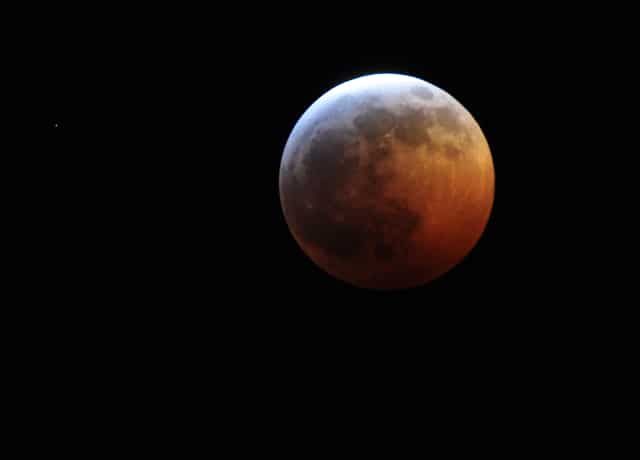Astronomy enthusiast Amir Burnett says that the best time to watch the white eclipse is not at the peak of the eclipse, but rather at its beginning or end, when you can notice the movement of the Earth's shadow on the surface of the Moon

The lunar eclipse will be visible tomorrow, June 15, in the entire area from Western China to Western Europe.
Because the moon is very close to the southernmost point it can reach, for Northern Hemisphere residents (which is most viewers) it will not rise very high in the sky during the night between June 15 and 16.
The beginning of the total eclipse at 22:21 The peak of the eclipse will be at 23:12 Israel time and it will end at 00:03, but for about an hour before the beginning of the eclipse and about an hour after it ends it will be possible to see a partial eclipse, during which parts of the moon are covered (or revealed), and it is worth watching the mountains that cause The shape of the Earth's shadow does not have to be a perfect arc.
During the eclipse it will be possible to see the moon in a dark red color, which it receives from the upper layers of the Earth's atmosphere.
In terms of the length of the total eclipse, this is the fifth longest eclipse of the current century. The longest eclipse will occur on July 27, 2018 and will last almost 104 minutes, and it will also be visible in roughly the same places on Earth.
Astronomy enthusiast Amir Burnett says that the best time to watch the white eclipse is not at the peak of the eclipse, but rather at its beginning or end, when you can notice the movement of the Earth's shadow on the surface of the Moon. At the peak of the eclipse, the moon will be very pale and its color will be reddish, the reason for this is that sunlight passing through the Earth's atmosphere is scattered more in the blue color than in the red. The red color is not completely dispersed and a little of it reaches and illuminates the surface of the moon.
Unlike a solar eclipse where the moon exactly covers the sun if we were to watch a white eclipse from the moon the earth would hide the sun and a large area around it. A nice measurement that can easily be done during a white eclipse is measuring the radius of the moon, all that is needed is to compare the size of the moon to the size of the shadow of the earth, and from this you can find out that the radius of the earth is about 4 times larger than the radius of the moon
During the observation, the association's volunteers will be deployed at more than 20 observation points throughout the country and will explain to the general public about the nature of the eclipse. Observations will also be held at other public observatories (from north to south): the Observatory in Kfar Mashhad, the Observatory in Givat Olga, the Observatory in Givatayim, the Weizmann Institute of Science, the Observatory in Ma'ale Adumim, the Ilan Ramon Center at Ben-Gurion University, and Beit Tezif in Be'er Sheva.
Observation of the total white eclipse will take place this Wednesday, June 15, from 21:30 p.m. onwards, in the Keller Science Garden at the Weizmann Institute of Science. Participants will be able to follow the eclipse on a large screen that will transmit the image obtained at the Karrar Observatory of the Weizmann Institute of Science, located at the top of the particle accelerator tower.
The Astronomical Complex at Technode will hold an event on the evening of the eclipse that will include a comprehensive lecture on eclipses in astronomy including many demonstrations and engaging the audience, and then, starting at 21:20 p.m. - near the beginning of the visible eclipse, an observation will be made with several telescopes, including the main telescope of Technode, which is considered one of the largest in Israel. The observation will continue into the night.
And the Barkat observatory in Maccabi-Reot will broadcast the eclipse live on the observatory's website.
And also as a bonus - a passage of the space station
And again it's Brent the moral because interested viewers are invited to come out shortly before the total eclipse begins and see one of Earth's artificial moons: the International Space Station. At 21:00 the space station will appear in the western direction and pass near the horizon towards the north. This passage will be quite low (at its height the station will be lower than 25 degrees above the horizon) so that buildings or trees may hide it. To get more information about this passage of the International Space Station, you can use the link above
http://heavens-above.com/PassSummary.aspx?satid=25544&lat=31.26285&lng=34.80503&loc=Ilan+Ramon+youth+physics+center&alt=0&tz=Israel
The times, directions and link are for the viewer located at the Ilan Ramon Center for Youth Seeking Physics at Ben Gurion University in the Negev, but are not expected to change significantly for viewers throughout the country.

3 תגובות
But above all, and all over the country, the Israeli Astronomical Society will perform dozens of free observations with telescopes. Starting from Hariya in the north to Beer Sheva in the south with the help of many volunteers. At all observations, flyers will be distributed and explanations will be given, all free of charge. Come one and all
Details on the association's website
http://www.astronomy.org.il
Good night and a pleasant observation tomorrow
Sabdarmish Yehuda
The Barkat observatory (Maccabim-Modiin) will also broadcast the eclipse in real time, you are invited to enter:
http://www.bareket-astro.com/live-astronomical-web-cast/live-lunar-eclipse-webcast-2011-event.html
I wanted to add that the observatory at the Weizmann Institute will transmit the images of the eclipse, as seen through the telescope, live at the following address:
http://video.weizmann.ac.il/davidson/live-astronomy.html